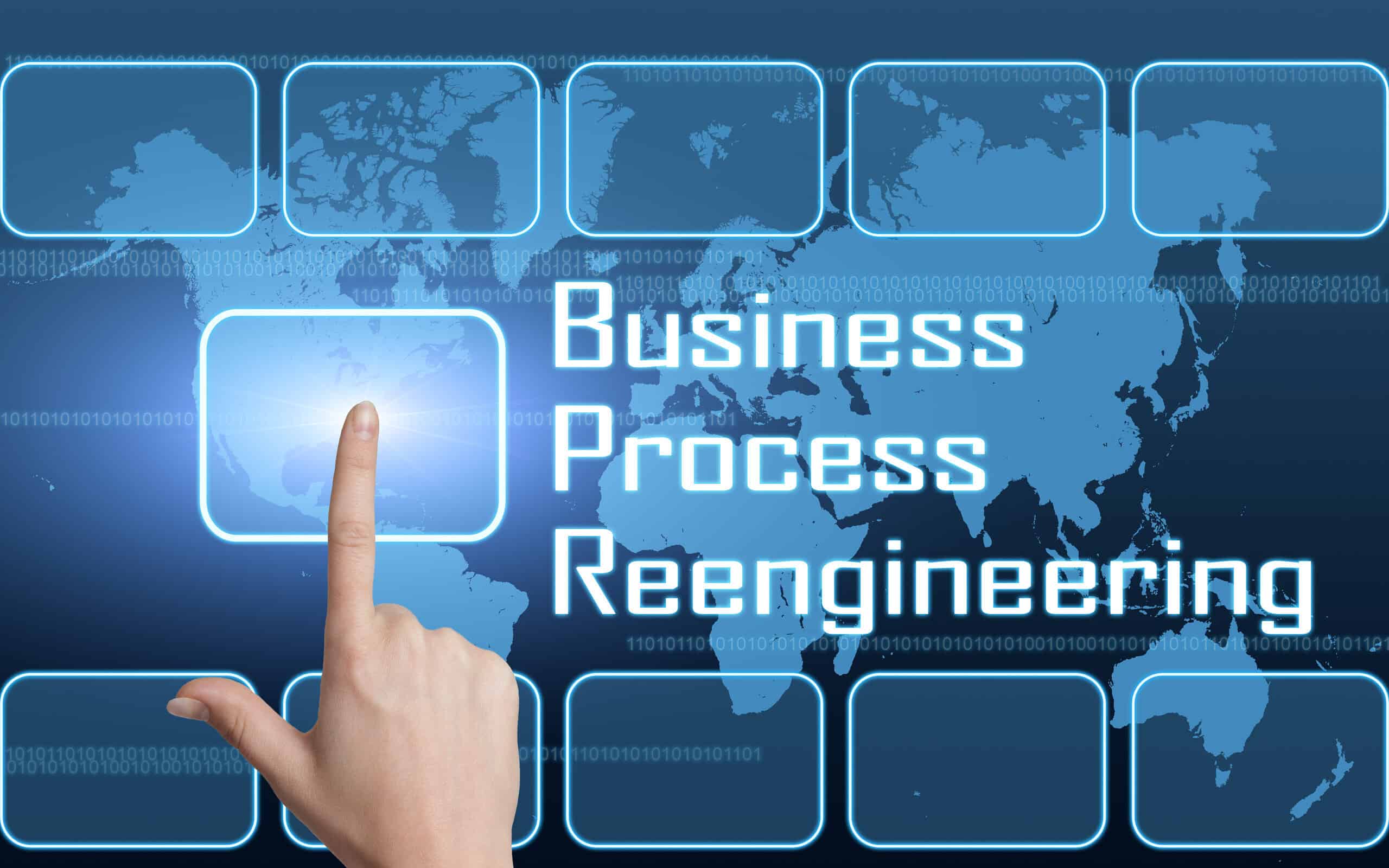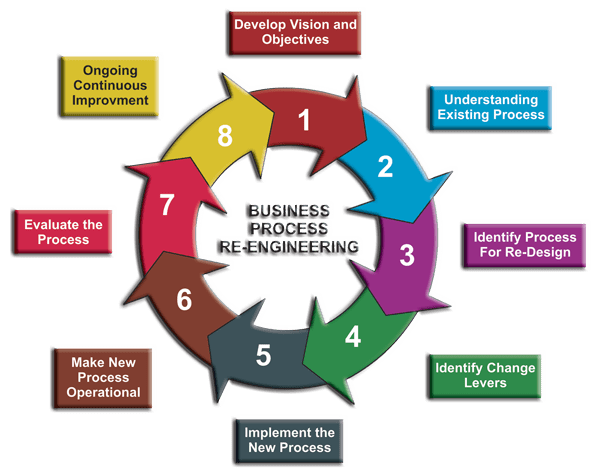
In the spirit of continuous improvement, re-engineering is the process by which you can identify, analyze, and re-design your organization’s core business processes for the purpose of achieving improvements in critical performance measures.
Reengineering, also known as business process reengineering (BPR), is a methodology that focuses on the fundamental redesign of business processes to achieve significant improvements in productivity, efficiency, and quality.
The concept of BPR was laid out in a 1990 Harvard Business Review article, “Reengineering Work: Don’t Automate, Obliterate” by the late Michael Hammer, a management author and professor of computer science at the Massachusetts Institute of Technology.
Overview: What is reengineering?
BPR involves the analysis and transformation of existing processes, workflows, and structures to identify opportunities for improvement, eliminate redundant steps, automate tasks, and streamline operations. Reengineering often requires a radical shift in the way your organization operates, and may involve changes to organizational culture, management practices, and technology infrastructure.
The goal of BPR is to create a leaner, more efficient, and more effective organization that is better equipped to meet the challenges of a rapidly changing business environment. It is often started in response to external pressures such as increased competition, changes in customer needs, regulatory requirements, or technological advancements.
The principles of reengineering can vary depending on the methodology and approach being used, but some common principles include:
- Process focus – focused on improving business processes, rather than isolated tasks or activities.
- Radical redesign – involves a radical redesign of business processes, rather than incremental improvements.
- Customer focus – focused on meeting the needs of the customer, rather than internal requirements or constraints.
- Top-down approach – requires strong leadership and a top-down approach to ensure buy-in and commitment from all stakeholders.
- Cross-functional teams – involves the use of cross-functional teams to bring together different perspectives and expertise.
- Simplicity – emphasizes simplicity, eliminating unnecessary steps and complexity to improve efficiency and effectiveness.
- Technology utilization – leverages technology to automate tasks, improve efficiency, and provide better data and analytics.
- Continuous improvement – is an ongoing process that requires continuous improvement and monitoring to sustain results.
Here is one version of the steps for executing BPR:

7 benefits of reengineering
Reengineering can provide numerous benefits to organizations, including:
Increased efficiency
By identifying and eliminating unnecessary steps in business processes, reengineering can improve efficiency, reduce cycle times, and increase productivity.
Improved quality
Reengineering can help organizations identify areas where quality can be improved by implementing better processes and practices.
Enhanced customer satisfaction
By improving processes, reengineering can lead to better customer service, faster response times, and increased customer satisfaction.
Cost savings
Reengineering can help reduce costs by eliminating redundant steps, reducing errors, and optimizing resource utilization.
Increased agility
By streamlining processes and eliminating bureaucracy, reengineering can enable your organization to be more agile and responsive to changes in the market or business environment.
Better utilization of technology
Reengineering can help organizations leverage technology to automate tasks and improve efficiency.
Competitive advantage
Reengineering can provide organizations with a competitive advantage by enabling them to operate more efficiently, effectively, and responsively than their competitors.
Why is reengineering important to understand?
Reengineering is important to understand for several reasons:
Increasing competitiveness
In today’s rapidly changing business environment, companies need to continually improve their operations to remain competitive. BPR can help you achieve significant improvements in efficiency, quality, and customer service, giving you a competitive edge.
Addressing inefficiencies
Over time, business processes can become inefficient, leading to wasted resources and increased costs. Reengineering helps to identify and eliminate these inefficiencies, reducing your costs and improving productivity.
Adapting to change
Reengineering can help your organization adapt to changes in the market, customer needs, or regulatory requirements. By identifying opportunities for improvement and implementing changes, you can stay ahead of the curve and be better prepared for the future.
Improving customer satisfaction
Reengineering can help you improve customer satisfaction by streamlining your processes and providing better service. This can lead to increased customer loyalty and repeat business.
Enhancing employee engagement
By involving employees in the reengineering process, you can improve employee engagement and morale. This can lead to increased productivity, better teamwork, and reduced turnover.
An industry example of reengineering
An example of reengineering for a bank involved the transformation of its lending process to make it more efficient and customer-focused. This involved the following steps:
- Process analysis – Conducting a thorough analysis of the bank’s lending process to identify areas for improvement, including bottlenecks, redundancies, and manual tasks.
- Redesign – Redesigning the lending process to eliminate unnecessary steps, automate tasks, and streamline operations. This involved the use of technology such as artificial intelligence and machine learning to automate underwriting and credit decisions.
- Customer focus – Redesigning the lending process to be more customer-focused, including simplifying the application process, providing faster turnaround times, and offering personalized loan options.
- Cross-functional teams – Bringing together cross-functional teams to design and implement the new lending process, including representatives from lending, technology, operations, and customer service.
- Testing and refining – Testing the new lending process thoroughly to ensure that it met the objectives of the reengineering effort. Refining the process as necessary based on feedback and results.
- Implementation and training – Implementing the new lending process across the organization, providing training and support to employees, and communicating the change to customers.
This reengineering effort resulted in significant improvements in the bank’s lending process, including faster turnaround times, better customer service, and reduced costs. It also provided a competitive advantage by enabling the bank to offer more personalized loan options and stay ahead of changes in the lending industry.
Best practices when thinking about reengineering
There are several best practices that can help ensure a successful reengineering effort:
Identify the scope of the reengineering effort
Define the scope of the reengineering effort upfront, including the business processes to be reengineered, the objectives of the effort, and the resources required.
Develop a clear plan and timeline
Develop a comprehensive plan for the reengineering effort, including timelines, milestones, and metrics for success. The plan should be communicated clearly to all stakeholders.
Involve employees and stakeholders
Involve employees and other stakeholders in the reengineering effort. This can help generate buy-in and commitment to the effort, and provide valuable insights into the current processes and opportunities for improvement.
Focus on the end-to-end process
Reengineering should focus on the end-to-end process rather than isolated activities or tasks. This ensures that improvements are made across the entire process and not just in one area.
Leverage technology where possible
Identify opportunities to leverage technology to automate tasks and improve efficiency. However, technology should be used to support the process, not drive it.
Test and refine the new process
Test the new process thoroughly to ensure that it meets the objectives of the reengineering effort. Refine the process as necessary based on feedback and results.
Monitor and measure results
Monitor and measure the results of the reengineering effort against the established metrics. Use this information to continuously improve the process and identify new opportunities for reengineering.
Frequently Asked Questions (FAQ) about reengineering
Some of the most frequently asked questions about reengineering include:
How can I identify areas for reengineering in my organization?
Areas for reengineering can be identified by analyzing processes that are inefficient, ineffective, or no longer meet business needs. Other areas to consider include processes that are heavily manual, have a high error rate, or are not customer-focused.
How long does a reengineering effort typically take?
The duration of a reengineering effort can vary depending on the scope of the effort, the complexity of the processes being reengineered, and the resources available. Typically, a reengineering effort can take several months to a year or more to complete.
What are the risks associated with reengineering?
Risks associated with reengineering can include resistance from employees and stakeholders, failure to achieve the desired results, and disruption to ongoing operations. Careful planning, communication, and stakeholder engagement can help minimize these risks.
What are the key success factors for reengineering?
Key success factors for reengineering include a clear scope and plan, stakeholder engagement, employee buy-in, strong project management, and a focus on measurable results.
How can technology be leveraged in reengineering efforts?
Technology can be leveraged in reengineering efforts to automate tasks, improve efficiency, and provide better data and analytics. However, technology should be used to support the process, not drive it.
How can the results of a reengineering effort be sustained over time?
Results of a reengineering effort can be sustained over time by developing strong change management processes, implementing ongoing monitoring and measurement, and providing ongoing training and support to employees.
Summary
Reengineering will have you disregard all the assumptions and traditions of the way your business has always been done, and instead develop a new, process-centered business organization that achieves a quantum leap forward in performance.
To achieve reengineering success, a fresh perspective and approach is required. A clean sheet of paper is taken and, given what is currently known about customers and their preferences, a new organization is developed which will optimize the process of creating satisfied customers.
Reengineering is the process by which the organization that exists today is replaced by the optimal version of the new organization. Reengineering is the opportunity to develop the rules by which your business in the future will be managed.
The keys to reengineering success are:
- Always start with the customer and work backwards.
- Move fast.
- Tolerate risk.
- Accept imperfections along the way.
- Don’t stop too soon.